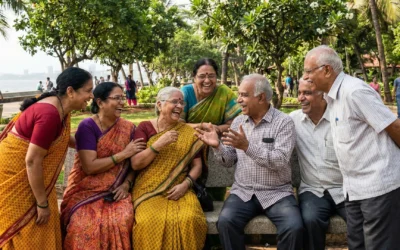As India’s population continues to age, it is crucial to increase the budgetary allocation for senior care to a minimum of 1 per cent and expand the initiatives to meet its growing demand.
It is imperative that the forthcoming Union Budget of India addresses the unique needs and challenges faced by the seniors. Particularly in the context of senior care reforms, it provides the government an opportunity to build on existing schemes and introduce strategic policy measures and increase the financial allocations further enhance the well- being of India’s increasing number of senior citizens.
Global Scenario
Investing in senior care is not just a moral obligation but also a strategic necessity to harness the experience and wisdom of the elderly, contributing to the overall development of the nation. Governments around the world have invested heavily to implement various social initiatives to focus on healthcare, social inclusion, financial security, and mental well-being.
The percentage of budgetary allocation towards senior citizen programmes varies widely across countries, influenced by demographic structures, policy priorities, and economic capabilities. In developed countries like the USA, significant portions of the budget are dedicated to social security and healthcare programs benefiting seniors. Some of the notable programs include Medicare, Medicaid (USA), and NHS (UK). In the case of some European countries like the UK and Germany, the budgetary allocation forms around 12 per cent to as high as 37 per cent in the USA.
Need to increase the budgetary allocation to minimum 1 per cent
In contrast, countries like India integrate senior citizen programmes within broader social welfare and healthcare budgets without a distinct percentage allocation. Understanding these allocations helps to highlight the varying levels of government commitment to supporting their aging populations. The allocation of around Rs 13,539 crores to the Ministry of Social Justice and Empowerment (MoSJE) in the Union Budget 2023-24 forms approximately only 0.30 per cent of the total budgetary allocation. MoSJE is the nodal body responsible for the welfare of senior citizens. Out of the budgetary allocation, only a portion gets allocated towards senior citizen programmes.
As the country’s population continues to age, it is crucial to increase the budgetary allocation for senior care alone to a minimum of 1 per cent to strengthen and expand the initiatives to meet the growing demands of senior care.
Resource Allocation – Time To Think Out Of The Box
While it is understandable that an increase in the financial allocation by 3X (from 0.3 per cent to 1 per cent) cannot be done overnight, the budget can at least set a goal and initiate steps in the forthcoming budget to augment the allocation via innovative approaches that go beyond traditional budget allocations. Here are 5 out-of-the-box ideas to help the Indian government generate more funds for senior care:
- Social Impact Bonds (SIBs)
Concept:
- Social Impact Bonds are a type of public-private partnership where private investors fund social programs upfront and are repaid by the government only if the programs achieve agreed-upon outcomes.
Implementation:
- Develop SIBs focused on senior care initiatives, such as improving healthcare access, reducing isolation, or enhancing home-based care services.
- Collaborate with private investors, non-profits, and service providers to design and implement these programs.
- Senior Care Cess
Concept:
- A small, targeted tax or cess on specific goods or services that can be directed towards funding senior care programmes.
Implementation:
- Introduce a nominal cess on luxury goods, high-end real estate transactions, or certain services, earmarking the proceeds specifically for senior care reforms.
- Ensure transparency in the use of these funds to maintain public trust and support.
- Utilising Unclaimed Funds
Concept:
- Redirect unclaimed funds from dormant bank accounts, unclaimed dividends, or inactive provident fund accounts towards senior care.
Implementation:
- Create a regulatory framework that allows the government to access these unclaimed funds legally.
- Use these funds to establish a dedicated senior care fund, ensuring strict oversight and accountability.
4. Corporate Social Responsibility (CSR) Towards Geriatric Care
Concept:
- Make it mandatory for companies to allocate at least 10 per cent of their CSR budgets towards senior care initiatives.
Implementation:
- Provide tax incentives or public recognition for companies that contribute a significant portion of their CSR funds to senior care.
- Create a platform to facilitate partnerships between corporations and senior care NGOs, ensuring efficient use of CSR funds.
Presently CSR funds mobilised amount to around Rs 25,000 crore per annum. Compulsory allocation of at least 10-15 per cent of the CSR funds can help mobilise at least Rs 2,500 crore, towards addressing senior citizen programs.
5. Seed Enterprise Investment Scheme (SEIS)
Overview:
The UK government has a Seed Enterprise Investment Scheme (SEIS) which aims to help very early-stage companies raise equity finance by offering tax reliefs to individual investors who buy new shares in those companies. The budget can similarly provide special incentives for investments specifically in AgeTech, Health tech startups which seek to address geriatric issues with following criteria:-
Key Features:
- Income Tax Relief: Investors can claim 50% income tax relief on investments of up to Rs 10,000,000 per tax year.
- Capital Gains Tax Exemption: No CGT is payable on the disposal of SEIS shares if they are held for at least three years.
- Loss Relief: If SEIS shares are disposed of at a loss, investors can offset the loss against their income tax or CGT liabilities.
- Capital Gains Reinvestment Relief: Half of the capital gains can be reinvested in SEIS shares to claim 50 per cent CGT exemption.
Eligibility:
- The entity must have promoter funds deployed of at least Rs 50 lakh
- The entity must have less than Rs 20,00,000 in gross assets before the investment.
- The entity must have fewer than 20 full-time employees.
By leveraging this scheme, startups can attract the necessary funding to innovate, grow, and contribute to economic development. These incentives not only help startups but also provide attractive opportunities for investors looking to support high-potential early-stage companies.
Innovative out of the box funding mechanisms can significantly enhance the resources available for senior care reforms in India. By leveraging public-private partnerships, creative financing tools, and community engagement, the government can ensure sustainable and impactful senior care initiatives. These out-of-the-box ideas, if implemented effectively, can help bridge the funding gap and provide better care and support for India’s growing elderly population.
Written by Salil Datar for Outlook Money: Retirement




